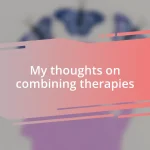Key takeaways:
- CRPS causes intense, chronic pain along with symptoms like swelling and emotional distress, significantly affecting one’s daily life and mental health.
- Research is crucial for developing effective CRPS treatments, contributing to improved patient outcomes and empowering individuals with knowledge to advocate for their care.
- Engaging with the CRPS community and exploring diverse treatment strategies, including physical therapy and mindfulness, can provide emotional support and enhance management of the condition.

Understanding Complex Regional Pain Syndrome
Complex Regional Pain Syndrome (CRPS) is a condition that often arises following an injury, leading to intense, chronic pain that seems disproportionate to the original trauma. I remember the first time I heard about CRPS; I was struck by how it could transform everyday life into a constant battle. It raises the question—how can pain become a living presence, shaping one’s reality?
The pain associated with CRPS is often accompanied by a variety of other symptoms, such as swelling, changes in skin color, and even temperature fluctuations in the affected limb. I recall speaking with a friend who experienced these symptoms firsthand. She passionately described the frustration of trying to explain her condition to others who just couldn’t fathom the severity of her experience, making me wonder—what does it take for society to truly acknowledge chronic pain that’s invisible?
Moreover, the emotional toll of CRPS is profound. I’ve seen individuals struggle with feelings of isolation, as the world around them carries on while they navigate their own pain-laden journey. This condition doesn’t just affect the body; it impacts mental health and relationships, leading me to ponder—how can we cultivate more understanding and support for those living with CREPS?

Importance of Research in CRPS
Research plays a crucial role in advancing our understanding of CRPS and developing effective treatments. I’ve often thought about how, without research, we’d be left relying solely on personal accounts and trial-and-error methods. For instance, innovative treatment options that can significantly impact quality of life emerge from rigorous studies, and when I see someone gain relief from pain due to a newly discovered method, it fills me with hope.
The urgency of this research really hits home when I reflect on my visit to a CRPS support group. There, I met individuals sharing their struggles and triumphs, and it became clear that some have benefited tremendously from treatments that were not available a decade ago. I couldn’t help but feel a sense of responsibility; every time researchers uncover something new, it’s a step closer to easing someone’s suffering. It’s a reminder of how critical it is to continue pushing the boundaries of what we know.
Moreover, by participating in and supporting CRPS research, we contribute to a body of knowledge that can change lives—not just for the current generation but for future patients. In my own experience, knowledge is empowering. The more I learn about CRPS, the better I can advocate for my needs and seek appropriate options. It’s like having a voice in a conversation that desperately needs to happen.
| Aspect | Importance |
|---|---|
| Advancement of Treatments | Research fosters innovative therapies that provide relief. |
| Understanding Patient Experiences | Research captures diverse experiences, guiding personalized care. |
| Future Innovations | Investing in research secures better outcomes for future patients. |

Effective Treatment Strategies to Explore
Exploring effective treatment strategies for CRPS can feel overwhelming, but I’ve discovered that some pathways show promise. When I first began seeking relief, I felt lost amidst countless options. However, focusing on a few targeted strategies allowed me to gain a clearer direction. It’s important to tailor these strategies to individual needs, as what works for one may not work for another.
Here are some treatment strategies worth discussing further:
- Physical Therapy: Through personalized exercises, I found that physical therapy improved my mobility while also helping to alleviate pain.
- Medication Management: Working closely with my healthcare provider to adjust medications taught me the importance of finding the right balance for pain relief without unwanted side effects.
- Cognitive Behavioral Therapy (CBT): Engaging in CBT sessions helped me reframe my pain experiences, ultimately reducing the emotional burden I felt.
- Nerve Blocks and Injections: I had a nerve block once that provided me with temporary but significant relief, illustrating how exploring interventional pain management can be worthwhile.
- Mind-Body Techniques: Practices like yoga and meditation became important tools for me to manage stress and enhance my overall wellbeing.
Each strategy has its own journey, and what resonated with me might inspire you to explore further. I remember attending a workshop where others shared their stories and I realized the immense strength in community and shared experiences. We are all navigating different aspects of this complex condition, and discovering new treatment options together is both enriching and empowering.

Personal Experiences in CRPS Management
Personal experiences in managing CRPS can be both enlightening and daunting. I recall one particularly tough day when the pain was relentless, and I felt utterly defeated. In that moment, I stumbled upon an online support group. The shared stories of others battling similar struggles ignited a spark in me. It’s incredible how connection can uplift the spirit. Have you ever felt alone in your struggles, only to find comfort in the camaraderie of others who understand?
Another aspect of my journey has been experimenting with various therapies. I distinctly remember the first time I experienced acupuncture; it was both a leap of faith and a moment of fear. Surprisingly, the session left me feeling surprisingly relaxed and provided relief that lasted longer than I anticipated. It’s fascinating how you never fully know the potential of a treatment until you try it for yourself. This unpredictability has often reminded me that being open to new strategies is key in CRPS management. Have you ever tried something that surprised you with its effectiveness?
Listening to my own body has also been a huge part of my management strategy. I used to push through the pain, thinking that endurance would make me stronger. But over time, I learned to embrace rest as a form of self-compassion. One evening, after a particularly exhausting week, I decided to spend the night with a good book and a cozy blanket instead of forcing myself to engage in an exhausting activity. The relief I felt was immense. Isn’t it interesting how sometimes doing less can lead to feeling more connected to our bodies?

Engaging with the CRPS Community
Engaging with the CRPS community has been one of the most rewarding aspects of my journey. I remember the first time I attended a local support group meeting. Walking into a room filled with people who shared similar struggles felt oddly comforting. Have you ever felt an instant connection with strangers over shared experiences? It’s empowering to know you’re not alone, and sharing our unique stories fosters a deep sense of solidarity.
Moreover, I’ve discovered the power of online platforms to connect with others dealing with CRPS. I joined several forums and social media groups, where I found people openly exchanging tips and personal triumphs. One heated discussion about pain management techniques caught my eye and changed my perspective entirely. What I learned about alternative approaches made me more curious and willing to try new strategies. It’s amazing how engaging with a diverse group can broaden our horizons and inspire personal growth.
It’s not just the exchange of information that enriches my experience; it’s the emotional support that truly resonates. During a particularly tough week, I shared my struggles on an online chat, expecting little response. To my surprise, the outpouring of support and kind words left me feeling significantly uplifted. Have you experienced the warmth of genuine encouragement from a community? It reinforces the idea that together, we can navigate this challenging journey with resilience and strength, one shared experience at a time.

Insights from Recent CRPS Studies
Recent studies on CRPS have unveiled some intriguing insights that resonate deeply with my own experiences. For instance, I came across research highlighting the significant role of psychological interventions in pain management. When I first tried mindfulness meditation, I wasn’t sure how it would help. However, I found that just a few minutes of focused breathing could shift my perspective, making the pain feel a bit more manageable. Have you ever tried something that seemed unrelated to your pain but ended up offering you a sense of relief?
Additionally, emerging evidence suggests that a multidisciplinary approach can enhance recovery outcomes for CRPS patients. I vividly remember my initial appointments with different specialists. Each brought a unique perspective, and together, they formed a comprehensive view of my condition. It was enlightening to discover how physical therapy complemented my pain management techniques, reinforcing the idea that collaboration in treatment could amplify results. Would you agree that sometimes, combining different therapies can yield surprising benefits?
Lastly, findings indicate that maintaining a regular exercise routine tailored for CRPS can significantly reduce symptoms. I used to shy away from physical activity, worried that it would exacerbate my pain. However, after following a specific, gentle exercise regimen suggested by my therapist, I realized that gradual movement not only helped in increasing my mobility but also boosted my mood. Isn’t it incredible how taking that first step can lead to unforeseen improvements?















